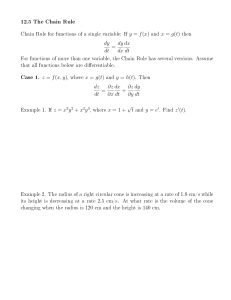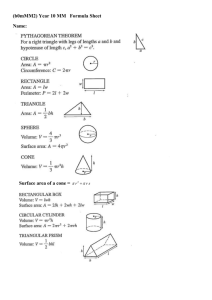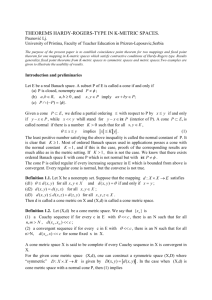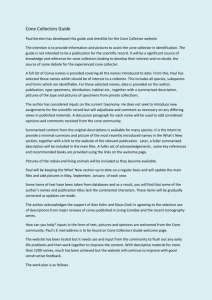Document 10677556
advertisement
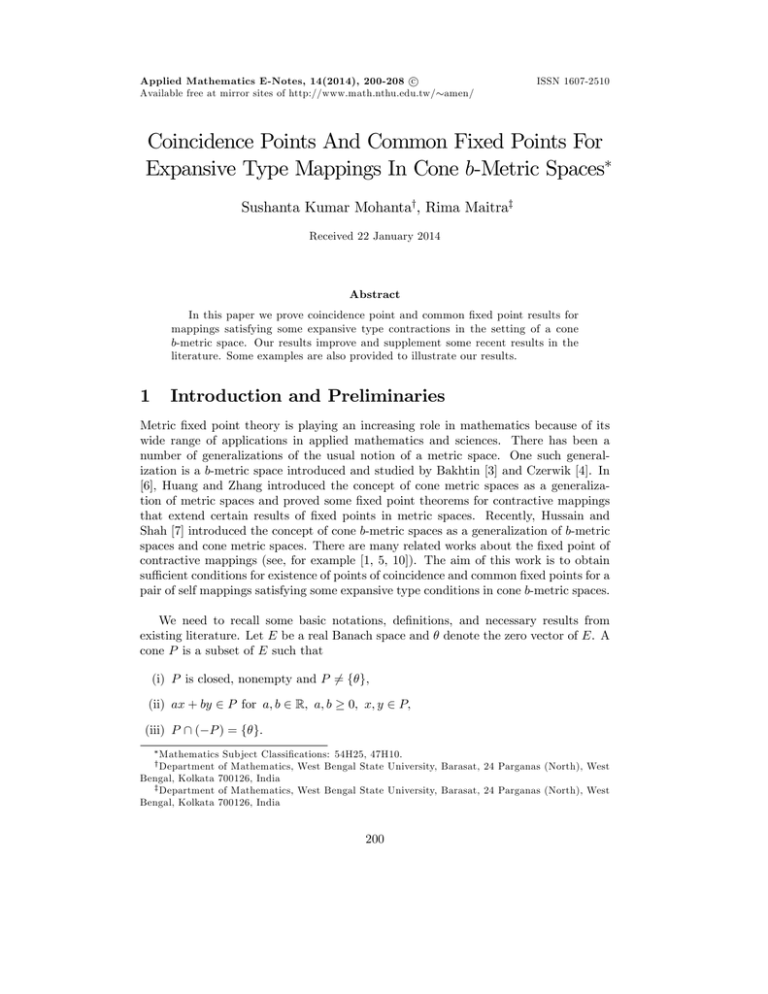
Applied Mathematics E-Notes, 14(2014), 200-208 c Available free at mirror sites of http://www.math.nthu.edu.tw/ amen/ ISSN 1607-2510 Coincidence Points And Common Fixed Points For Expansive Type Mappings In Cone b-Metric Spaces Sushanta Kumar Mohantay, Rima Maitraz Received 22 January 2014 Abstract In this paper we prove coincidence point and common …xed point results for mappings satisfying some expansive type contractions in the setting of a cone b-metric space. Our results improve and supplement some recent results in the literature. Some examples are also provided to illustrate our results. 1 Introduction and Preliminaries Metric …xed point theory is playing an increasing role in mathematics because of its wide range of applications in applied mathematics and sciences. There has been a number of generalizations of the usual notion of a metric space. One such generalization is a b-metric space introduced and studied by Bakhtin [3] and Czerwik [4]. In [6], Huang and Zhang introduced the concept of cone metric spaces as a generalization of metric spaces and proved some …xed point theorems for contractive mappings that extend certain results of …xed points in metric spaces. Recently, Hussain and Shah [7] introduced the concept of cone b-metric spaces as a generalization of b-metric spaces and cone metric spaces. There are many related works about the …xed point of contractive mappings (see, for example [1, 5, 10]). The aim of this work is to obtain su¢ cient conditions for existence of points of coincidence and common …xed points for a pair of self mappings satisfying some expansive type conditions in cone b-metric spaces. We need to recall some basic notations, de…nitions, and necessary results from existing literature. Let E be a real Banach space and denote the zero vector of E. A cone P is a subset of E such that (i) P is closed, nonempty and P 6= f g; (ii) ax + by 2 P for a; b 2 R; a; b 0; x; y 2 P; (iii) P \ ( P ) = f g: Mathematics Subject Classi…cations: 54H25, 47H10. of Mathematics, West Bengal State University, Barasat, 24 Parganas (North), West Bengal, Kolkata 700126, India z Department of Mathematics, West Bengal State University, Barasat, 24 Parganas (North), West Bengal, Kolkata 700126, India y Department 200 S. K. Mohanta and R. Maitra 201 For any cone P E, we can de…ne a partial ordering on E with respect to P by x y (equivalently, y x) if and only if y x 2 P . We shall write x y (equivalently, y x) if x y and x 6= y, while x y will stand for y x 2 int(P ), where int(P ) denotes the interior of P . The cone P is called normal if there is a number k > 0 such that for all x; y 2 E, x y implies kxk k kyk: The least positive number satisfying the above inequality is called the normal constant of P . Throughout this paper, we suppose that E is a real Banach space, P is a cone in E with int(P ) 6= ; and is a partial ordering on E with respect to P . DEFINITION 1.1 ([6]). Let E be a real Banach space with cone P and let X be a nonempty set. Suppose the mapping d : X X ! E satis…es (i) d(x; y) for all x; y 2 X and d(x; y) = if and only if x = y; (ii) d(x; y) = d(y; x) for all x; y 2 X; (iii) d(x; y) d(x; z) + d(z; y) for all x; y; z 2 X: Then d is called a cone metric on X, and (X; d) is called a cone metric space. DEFINITION 1.2 ([7]). Let X be a nonempty set and E a real Banach space with cone P . A vector valued function d : X X ! E is said to be a cone b-metric function on X with the constant s 1 if the following conditions are satis…ed: (i) d(x; y) for all x; y 2 X and d(x; y) = if and only if x = y; (ii) d(x; y) = d(y; x) for all x; y 2 X; (iii) d(x; y) s (d(x; z) + d(z; y)) for all x; y; z 2 X. The pair (X; d) is called a cone b-metric space. Observe that if s = 1, then the ordinary triangle inequality in a cone metric space is satis…ed, however it does not hold true when s > 1. Thus the class of cone b-metric spaces is e¤ectively larger than that of the ordinary cone metric spaces. That is, every cone metric space is a cone b-metric space, but its converse need not be true. The following examples illustrate these facts. EXAMPLE 1.3 ([7]). Let X = f 1; 0; 1g, E = R2 , P = f(x; y) : x 0; y 0g. De…ne d : X X ! P by d(x; y) = d(y; x) for all x; y 2 X; d(x; x) = ; x 2 X and d( 1; 0) = (3; 3); d( 1; 1) = d(0; 1) = (1; 1). Then (X; d) is a cone b-metric space, but not a cone metric space since the triangle inequality is not satis…ed. Indeed, we have d( 1; 1) + d(1; 0) = (1; 1) + (1; 1) = (2; 2) It is easy to verify that s = 23 . (3; 3) = d( 1; 0): 202 Coincidence Points and Common Fixed Points EXAMPLE 1.4 ([8]). Let E = R2 , P = f(x; y) : x 0; y 0g d : X X ! E such that d(x; y) = (j x y jp ; j x y jp ) where are two constants. Then (X; d) is a cone b-metric space with s = 2p metric space. E; X = R and 0 and p > 1 1 , but not a cone DEFINITION 1.5 ([7]). Let (X; d) be a cone b-metric space, x 2 X and (xn ) be a sequence in X. Then (i) (xn ) converges to x whenever, for every c 2 E with c, there is a natural number n0 such that for all n > n0 , d(xn ; x) c. We denote this by limn!1 xn = x or xn ! x (n ! 1); (ii) (xn ) is a Cauchy sequence whenever, for every c 2 E with natural number n0 such that d(xn ; xm ) c for all n; m > n0 ; c, there is a (iii) (X; d) is a complete cone b-metric space if every Cauchy sequence is convergent. REMARK 1.6 ([7]). Let (X; d) be a cone b-metric space over the ordered real Banach space E with a cone P . Then the following properties are often used: (i) If a b and b c, then a c. (ii) If a b and b c, then a c. (iii) If u c for each c 2 int(P ), then u = . (iv) If c 2 int(P ); we have an c. an and an ! , then there exists n0 such that for all n > n0 (v) Let c. If d(xn ; x) bn and bn ! , then eventually d(xn ; x) (xn ); x are a sequence and a given point in X. (vi) If an bn and an ! a; bn ! b, then a b, for each cone P . (vii) If E is a real Banach space with cone P and if a then a = . (viii) int(P ) (ix) For each int(P ) for c, where a where a 2 P and 0 < 1, > 0. > 0 and x 2 int(P ) there is 0 < < 1 such that k x k< . (x) For each c2 d. c1 and c2 2 P , there is an element d such that c1 d and (xi) For each e c2 . c1 and e such that e c1 and c2 , there is an element S. K. Mohanta and R. Maitra 203 DEFINITION 1.7. Let (X; d) be a cone b-metric space and let T : X ! X be a given mapping. We say that T is continuous at x0 2 X if T xn ! T x0 as n ! 1 for every sequences (xn ) in X satisfying xn ! x0 as n ! 1. If T is continuous at each point x0 2 X, then we say that T is continuous on X. DEFINITION 1.8. Let (X; d) be a cone b-metric space with the constant s 1. A mapping T : X ! X is called expansive if there exists a real constant k > s such that d(T x; T y) k d(x; y) for all x; y 2 X: DEFINITION 1.9 ([2]). Let T and S be self mappings of a set X. If y = T x = Sx for some x in X, then x is called a coincidence point of T and S and y is called a point of coincidence of T and S. DEFINITION 1.10 ([9]). The mappings T; S : X ! X are weakly compatible, if for every x 2 X, the following holds: T (Sx) = S(T x) whenever Sx = T x: PROPOSITION 1.11 ([2]). Let S and T be weakly compatible selfmaps of a nonempty set X. If S and T have a unique point of coincidence y = Sx = T x, then y is the unique common …xed point of S and T . 2 Main Results In this section, we prove point of coincidence and common …xed point results in cone b-metric spaces. THEOREM 2.1. Let (X; d) be a cone b-metric space with the constant s 1. Suppose the mappings f; g : X ! X satisfy g(X) f (X), either f (X) or g(X) is complete, and d(f x; f y) d(gx; gy) + d(f x; gx) + d(f y; gy) for all x; y 2 X; (1) where ; ; are nonnegative real numbers with + + > s; < 1 and 6= 0. Then f and g have a point of coincidence in X. Moreover, if > 1, then the point of coincidence is unique. If f and g are weakly compatible and > 1, then f and g have a unique common …xed point in X. PROOF. Let x0 2 X and choose x1 2 X such that gx0 = f x1 . This is possible since g(X) f (X). Continuing this process, we can construct a sequence (xn ) in X such that f xn = gxn 1 , for all n 1. By (1), we have d(gxn 1 ; gxn ) = d(f xn ; f xn+1 ) d(gxn ; gxn+1 ) + d(f xn ; gxn ) + d(f xn+1 ; gxn+1 ) = d(gxn ; gxn+1 ) + d(gxn 1 ; gxn ) + d(gxn ; gxn+1 ) 204 Coincidence Points and Common Fixed Points which gives that d(gxn ; gxn+1 ) where = 1 + . It is easy to see that d(gxn 2 (0; n d(gxn ; gxn+1 ) for all n 1 s ). 1 ; gxn ) By induction, we get that d(gx0 ; gx1 ) (2) 0. Let m; n 2 N with m > n. Then, by using condition (2) we have d(gxn ; gxm ) s [d(gxn ; gxn+1 ) + d(gxn+1 ; gxm )] sd(gxn ; gxn+1 ) + s2 d(gxn+1 ; gxn+2 ) + +sm s n s n = s n s 1 n 1 [d(gxm 2 n+1 +s 2 n+1 +s + 2 ; gxm 1 ) + d(gxm 1 ; gxm )] m n 1 m 2 m n 1 m 1 +s +s m n 1 m 2 + +s 2 +s m n 2 1 + s + (s ) + m n m 1 + (s ) + (s ) d(gx0 ; gx1 ) d(gx0 ; gx1 ) m n 1 d(gx0 ; gx1 ) n d(gx0 ; gx1 ): s (3) n It is to be noted that 1s s d(gx0 ; gx1 ) ! can …nd m0 2 N such that s 1 as n ! 1. Let c be given. Then we n d(gx0 ; gx1 ) s c for each n > m0 : Therefore, it follows from (3) that s d(gxn ; gxm ) 1 n s d(gx0 ; gx1 ) c for all m > n > m0 : So (gxn ) is a Cauchy sequence in g(X). Suppose that g(X) is a complete subspace of X. Then there exists y 2 g(X) f (X) such that gxn ! y and also f xn ! y. In case, f (X) is complete, this holds also with y 2 f (X). Let u 2 X be such that f u = y. c For c, one can choose a natural number n0 2 N such that d(y; gxn ) 2s and c d(f xn ; f u) 2s for all n > n0 . By (1), we have d(gxn 1 ; f u) = d(f xn ; f u) d(gxn ; gu) + d(f xn ; gxn ) + d(f u; gu) d(gxn ; gu): If 6= 0, then d(gxn ; gu) 1 d(gxn 1 ; f u): Therefore, d(y; gu) s[d(y; gxn ) + d(gxn ; gu)] 1 s[d(y; gxn ) + d(gxn 1 ; f u)] = s[d(y; gxn ) + 1 d(f xn ; f u)] c; f or all n > n0 : S. K. Mohanta and R. Maitra 205 This gives that d(y; gu) = , i.e., gu = y and hence f u = gu = y. Therefore, y is a point of coincidence of f and g. Now we suppose that > 1. Let v be another point of coincidence of f and g. So f x = gx = v for some x 2 X. Then d(y; v) = d(f u; f x) d(gu; gx) + d(f u; gu) + d(f x; gx) = d(y; v); which implies that d(y; v) 1 d(y; v): By Remark 1:6(vii), we have d(v; y) = i.e., v = y. Therefore, f and g have a unique point of coincidence in X. If f and g are weakly compatible, then by Proposition 1:11, f and g have a unique common …xed point in X. The proof is complete. COROLLARY 2.2. Let (X; d) be a cone b-metric space with the constant s Suppose the mappings f; g : X ! X satisfy the condition d(f x; f y) 1. d(gx; gy) for all x; y 2 X; where > s is a constant. If g(X) f (X) and f (X) or g(X) is complete, then f and g have a unique point of coincidence in X. Moreover, if f and g are weakly compatible, then f and g have a unique common …xed point in X. PROOF. It follows by taking = = 0 in Theorem 2:1. The following corollary is the Theorem 2:1 [8]. s COROLLARY 2.3. Let (X; d) be a complete cone b-metric space with the constant 1. Suppose the mapping g : X ! X satis…es the contractive condition d(gx; gy) d(x; y) for all x; y 2 X; where 2 [0; 1s ) is a constant. Then g has a unique …xed point in X. Furthermore, the iterative sequence (g n x) converges to the …xed point. PROOF. It follows by taking Theorem 2:1. s = = 0 and f = I, the identity mapping on X, in COROLLARY 2.4. Let (X; d) be a complete cone b-metric space with the constant 1. Suppose the mapping f : X ! X is onto and satis…es d(f x; f y) where d(x; y) for all x; y 2 X; > s is a constant. Then f has a unique …xed point in X. PROOF. Taking g = I and = = 0 in Theorem 2:1, we obtain the desired result. REMARK 2.5. Corollary 2:4 gives a su¢ cient condition for the existence of unique …xed point of an expansive mapping in cone b-metric spaces. 206 s Coincidence Points and Common Fixed Points COROLLARY 2.6. Let (X; d) be a complete cone b-metric space with the constant 1. Suppose the mapping f : X ! X is onto and satis…es the condition d(f x; f y) d(x; y) + d(f x; x) + d(f y; y) for x; y 2 X; where ; ; are nonnegative real numbers with 6= 0; < 1; + + > s. Then f has a …xed point in X. Moreover, if > 1, then the …xed point of f is unique. PROOF. It follows by taking g = I in Theorem 2:1. s THEOREM 2.7. Let (X; d) be a complete cone b-metric space with the constant 1. Suppose the mappings S; T : X ! X satisfy the following conditions: d(T (Sx); Sx) + k d(T (Sx); x) s d(Sx; x) (4) and k d(S(T x); x) d(T x; x) (5) s for all x 2 X, where ; ; k are nonnegative real numbers with > s + (1 + s)k and > s + (1 + s)k. If S and T are continuous and surjective, then S and T have a common …xed point in X. d(S(T x); T x) + PROOF. Let x0 2 X be arbitrary and choose x1 2 X such that x0 = T x1 . This is possible since T is surjective. Since S is also surjective, there exists x2 2 X such that x1 = Sx2 . Continuing this process, we can construct a sequence (xn ) in X such that x2n = T x2n+1 and x2n 1 = Sx2n for all n 2 N. Using (4), we have for n 2 N [ f0g d(T (Sx2n+2 ); Sx2n+2 ) + k d(T (Sx2n+2 ); x2n+2 ) s d(Sx2n+2 ; x2n+2 ) which implies that d(x2n ; x2n+1 ) + k d(x2n ; x2n+2 ) s d(x2n+1 ; x2n+2 ): Hence, we have d(x2n+1 ; x2n+2 ) d(x2n ; x2n+1 ) + kd(x2n ; x2n+1 ) + kd(x2n+1 ; x2n+2 ): Therefore, 1+k d(x2n ; x2n+1 ): k Using (5) and by an argument similar to that used above, we obtain that d(x2n+1 ; x2n+2 ) d(x2n ; x2n+1 ) Let = max 1+kk ; and (7), we get 1+k k 1+k d(x2n k . It is easy to see that d(xn ; xn+1 ) d(xn 1 ; x2n ): (6) (7) 2 (0; 1s ). Then, by combining (6) 1 ; xn ) (8) S. K. Mohanta and R. Maitra for all n 207 1. By repeated application of (8), we obtain d(xn ; xn+1 ) n d(x0 ; x1 ): By an argument similar to that used in Theorem 2.1, it follows that (xn ) is a Cauchy sequence in X. Since X is complete, there exists u 2 X such that xn ! u as n ! 1. Now, x2n+1 ! u and x2n ! u as n ! 1. The continuity of S and T imply that T x2n+1 ! T u and Sx2n ! Su as n ! 1 i.e., x2n ! T u and x2n 1 ! Su as n ! 1. The uniqueness of limit yields that u = Su = T u. Hence, u is a common …xed point of S and T . The proof is complete. s COROLLARY 2.8. Let (X; d) be a complete cone b-metric space with the constant 1. Let T : X ! X be a continuous surjective mapping such that d(T 2 x; T x) + k d(T 2 x; x) s d(T x; x) for all x 2 X; where ; k are nonnegative real numbers with point in X. > s + (1 + s)k. Then T has a …xed PROOF. It follows from Theorem 2:7 by taking S = T and = . We conclude this paper with the following two examples. EXAMPLE 2.9. Let E = R2 , the Euclidean plane and P = f(x; y) 2 R2 : x; y 0g a cone in E. Let X = [0; 1] and p > 1 be a constant. We de…ne d : X X ! E as d(x; y) = (j x y jp ; j x y jp ) for all x; y 2 X: Then (X; d) is a cone b-metric space with the constant s = 2p 1 . Let us de…ne f; g : x2 X ! X as f x = x3 and gx = x9 27 for all x 2 X. Then, for every x; y 2 X one has d(f x; f y) 3p d(gx; gy) i.e., the condition (1) holds for = 3p ; = = 0. Thus, we have all the conditions of Theorem 2:1 and 0 2 X is the unique common …xed point of f and g. EXAMPLE 2.10. Let E = R2 and P = f(x; y) 2 R2 : x; y X = [0; 1). We de…ne d : X X ! E as d(x; y) = (j x y j2 ; j x 0g a cone in E. Let y j2 ) for all x; y 2 X: Then (X; d) is a complete cone b-metric space with the constant s = 2. Let us de…ne S; T : X ! X as Sx = 3x and T x = 4x for all x 2 X. Then, the conditions (4) and (5) hold for = = 3 + 3k > s + (1 + s)k, where k is a nonnegative real number. We see that all hypotheses of Theorem 2:7 are satis…ed and 0 2 X is a common …xed point of S and T . Acknowledgment. The authors would like to express their thanks to the referees for their valuable comments and useful suggestions. 208 Coincidence Points and Common Fixed Points References [1] M. A. Alghamdi, N. Hussain and P. Salimi, Fixed point and coupled …xed point theorems on b-metric-like spaces, J. Inequal. Appl., 2013, 2013:402, 25 pp. [2] M. Abbas and G. Jungck, Common …xed point results for noncommuting mappings without continuity in cone metric spaces, J. Math. Anal. Appl., 341(2008), 416– 420. [3] I. A. Bakhtin, The contraction mapping principle in almost metric spaces, Funct. Anal.,Gos. Ped. Inst. Unianowsk, 30(1989), 26–37. [4] S. Czerwik, Contraction mappings in b-metric spaces, Acta Math. Inform. Univ. Ostrav, 1(1993), 5–11. [5] Z. M. Fadail and A. G. B. Ahmad, Coupled coincidence point and common coupled …xed point results in cone b-metric spaces, Fixed Point Theory Appl., 2013, 2013:177, 14 pp. [6] L.-G.Huang and X. Zhang, Cone metric spaces and …xed point theorems of contractive mappings, J. Math. Anal. Appl., 332(2007), 1468–1476. [7] N. Hussain and M. H. Shah, KKM mappings in cone b-metric spaces, comput. Math. Appl., 62(2011), 1677–1684. [8] H. Huang and S. Xu, Fixed point theorems of contractive mappings in cone bmetric spaces and applications, Fixed Point Theory Appl. 2013, 2013:112, 10 pp. [9] G. Jungck, Common …xed points for noncontinuous nonself maps on non-metric spaces, Far East J. Math. Sci., 4(1996), 199–215. [10] J. R. Roshan, V. Parvaneh, S. Sedghi, N. Shobkolaei and W. Shatanawi, Common …xed points of almost generalized ( ; ')s -contractive mappings in ordered b-metric spaces, Fixed Point Theory Appl. 2013, 2013:159, 23 pp.


